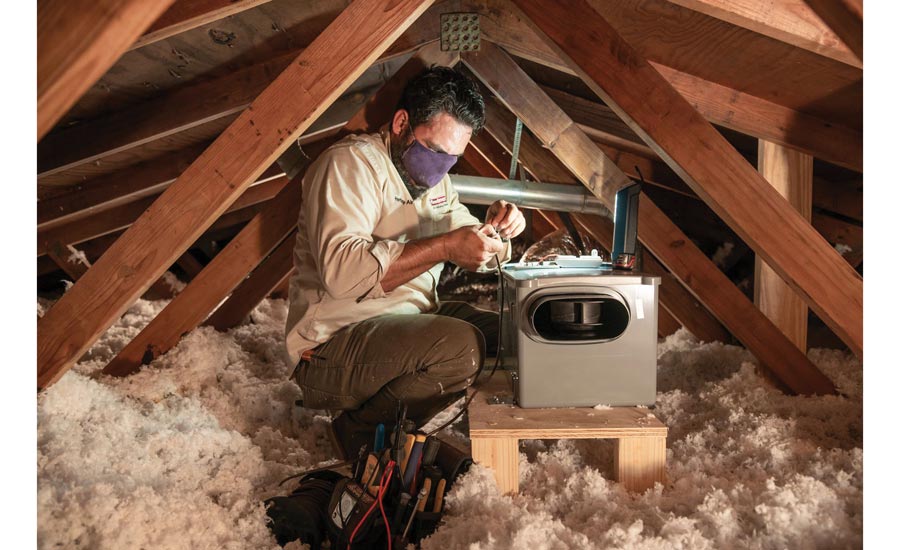The COVID-19 pandemic has increased interest in indoor air quality among residential consumers several ways. One is a desire to feel more secure in their home environment. A survey by the IBM Institute for Business Value found 70 percent of respondents said COVID-19 has made them more concerned about the safety and health of themselves and their families.
The other way the pandemic spurs interest in IAQ is by having those consumers spend more time in their home environments than they ever have before. Homes have become more than the places where people hang their hats. They are now used as offices, school rooms, gyms, and a myriad of other functions that were once located in other buildings.
“IAQ product demand has, in general, been higher than furnace or unitary shipments as contractors react to the specific problems associated with indoor air during the pandemic,” said Tom Ruse, marketing project manager for Aprilaire. “We know the overall number of contractors quoting IAQ products has increased and higher close rates have followed.”
IAQ was already a growing field. Contractors can now offer consumers all types of solutions to any problem. This should be a tremendous opportunity for HVAC contractors and it is for those who know how to capitalize on it. But like any other market, it takes knowledge and training.
HVAC Contractors Need Knowledge About IAQ
Manufacturers are trying to help HVAC contractors and their staffs better understand all the different IAQ options. Ruse said. Aprilaire has been running multiple online webinars as well as conducting small group virtual meetings with distributors and contractors. Attendance at these events is through the roof, he said.
James Bowman, retail operations manager at Davis Air Conditioning and Heating, said he sees a definite increase in IAQ solutions from residential clients. However, the interest is spiking at the same time the economy is struggling.

NOT THE HEAT BUT THE HUMIDITY: A dehumidifier, such as this one, helps cut down on biogrowth. Reaching a balance between too much and too little humidity is one of the many challenges of IAQ.
Some of the options are fairly expensive, Bowman said. People are willing to spend if educated properly about their options. This makes it more crucial than ever that the technicians understand the technology.
“You can quote and you can sell,” Bowman said. “Selling requires taking time to educate about what it will and won’t do. What we don’t want people to do is go out and promise it will do something that it will not.”
Dave Pawlicki, business development leader at Owens Corning, cautions about the risk of overpromising. For example, Owen Corning’s duct liners feature an anti-microbial component. This will not kill a virus, Pawlicki said. Making it seem like a COVID killer would only harm consumer trust. And Pawlicki said studies show consumers are already wary of HVAC contractors.
What the anti-microbial component does do is discourage biogrowth — although this growth, which includes mold and algae, may still occur, Pawlicki said, due to dust and humidity. Pawlicki has seen himself what a difference this can make when he had new ducts installed in his home. A long-time asthma sufferer, he reports far fewer symptoms now. Despite the validity of the products and consumer demand, Pawlicki said many contractors remain hesitant to discuss these large investments.
Interest in IAQ Shows HVAC Contractors Care
Contractor program director AirAdvice for Homes
AirAdvice for Homes helps in the sales process by offering a tool that allows techs to perform a 30-minute analysis of a home’s indoor air quality. Jeff Mounts, the company’s contractor program director, said opportunities to sell IAQ solutions are vast. The challenge is that most consumers traditionally haven’t thought about the topic until presented with it.
“People don’t know about the air quality of their homes,” Mounts said.
Mounts said the most successful HVAC contractors make IAQ analysis part of any call. It’s more than a sales opportunity, Mounts said. It tells homeowners a contractor is looking out for them.
“What technician do you want in your house: the one who says, ‘Hey, do you want to know more about this?’ or the one who ignores it?” he said.
One of the main areas in need of being addressed is usually filtration, Mounts said. A study of 50,000 AirAdvice reports found that more than 70 percent of homes have elevated particles. These are microscopic particles that people regularly inhale. That may seem harmless, but Mounts said the opposite is true.
“The smaller the particles, the more harmful they are,” he said.
This is a reason for a strong filtration system. However, a new challenge has arisen with the increased popularity of mini splits — especially lately, as people seek zoning solutions. There is no central filter for these units, Bowman said. The filtration that does exist is limited because mini splits are designed to be low static. Bowman said ductless is a great technology but requires more advanced IAQ solutions.
Swimming in a Chemical Soup
Another major issue is ventilation. Mounts said the AirAdvice study found 60 percent of homes are underventilated — or, to use a more common term, stuffy. People have worked to make homes airtight, he said. They haven’t worked to ensure the necessary air exchanges.
Bowman said proper ventilation is a balancing act.

COMFORT MATTERS: A technician works on the controls for a home’s HVAC. Comfort counts as part of overall IAQ.
“You’re bringing in fresh air, you’re bringing in allergens, heat, and humidity,” he said. “If you don’t bring in fresh air, you’ve got a home that’s recirculating all kinds of contaminants.”
Houses today are also designed to keep out humidity. Unfortunately, the same material that keeps out humidity can keep it in, and houses lately are becoming much more humid. Houses weren’t designed for all these people to be home all the time, Bowman said. A house today may be filled at all times with five people and several pets. All of them are producing humidity.
The right amount of humidity is good, Mounts said. It stops irritants like dust mites. In an area like Houston, however, too much humidity creates problems with biogrowth. Again, it’s a balancing act, Bowman said. Mounts said HVAC contractors can offer solutions like germicidal UV lights to solve these problems.
In addition to installing mini splits and creating humidity, people have spent a lot of time cleaning their homes in the past few months. This creates another IAQ issues. Mounts said his company’s study found 40 percent of homes have elevated chemicals.
“We swim in a chemical soup, and we’re largely oblivious to it,” Mount said.
Permanant Shift in Consumer Thinking
Many of these issues are going to outlast the COVID pandemic. Bowman said he expects new building codes will put IAQ front and center. Even without any regulation, consumers will drive a change, Ruse said.
“The mindset is healthier environments forever,” he said. “Post-COVID, it will be that much more meaningful as homeowners, builders, and property managers build health into our way of life when it comes to the structure of homes and businesses.
“Think of it in terms of how airport security changed because of 9/11. It never went back. We still take our shoes off. Security measures stuck, and so will demand for healthier living choices.”








